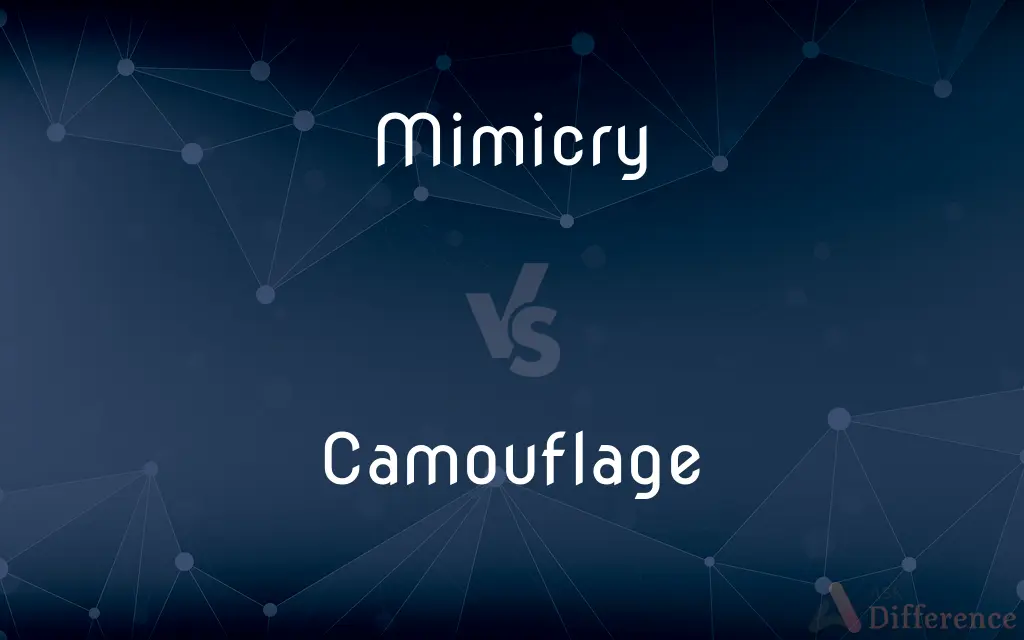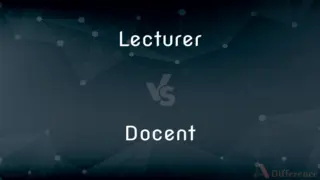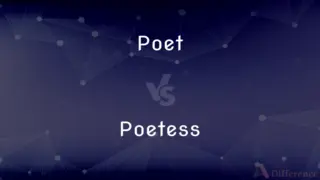Mimicry vs. Camouflage — What's the Difference?
Edited by Tayyaba Rehman — By Urooj Arif — Updated on April 15, 2024
Mimicry involves one species resembling another for protection, while camouflage involves an organism blending into its surroundings to avoid detection.

Difference Between Mimicry and Camouflage
Table of Contents
ADVERTISEMENT
Key Differences
Mimicry is an evolutionary adaptation where one species evolves to imitate the appearance of another, often more dangerous or distasteful species. This resemblance can deceive predators into avoiding the mimic. Camouflage, on the other hand, is the ability of an organism to alter its appearance or color to match its environment, thus hiding from predators or prey.
Animals like the monarch butterfly exhibit mimicry, where their bright colors, which indicate toxicity, are mimicked by other non-toxic butterflies to deter predators. Whereas, a chameleon changes its skin color to blend in with its surroundings, effectively hiding from both predators and prey.
Mimicry often involves specific signals such as the shape, color, and behavior that closely resemble those of another species. Camouflage, however, can be as simple as having a coloration that matches the background or as complex as displaying disruptive patterns that break up the organism’s outline.
Some organisms use mimicry as a form of aggressive deception, like the anglerfish, whose lure mimics small prey to attract other fish. In contrast, camouflage is primarily defensive, used by animals like the stick insect, which resembles twigs and leaves to avoid notice entirely.
The effectiveness of mimicry depends largely on the presence of the model species in the same area; without them, the mimic’s deception may fail. Conversely, the success of camouflage relies on the stability of the environment and the ability of the organism to remain undetected in changing conditions.
ADVERTISEMENT
Comparison Chart
Purpose
To mimic another species for safety
To blend into the environment
Type of adaptation
Behavioral and physical
Primarily physical
Dependency
Relies on the existence of a model
Depends on the environment
Common examples
Monarch and viceroy butterflies
Chameleons, stick insects
Predominant function
Deception
Concealment
Compare with Definitions
Mimicry
Mimicry also occurs in plants, sometimes in shape or color to attract pollinators.
Some orchids use mimicry to look like female bees, attracting males for pollination.
Camouflage
Cryptic coloration is a form of camouflage that involves matching the colors of the background.
A flounder can change its skin pattern to match the sandy ocean floor.
Mimicry
A biological phenomenon where an organism imitates another to gain an advantage.
Mimicry in butterflies can involve harmless species copying the warning colors of toxic ones.
Camouflage
Camouflage is a common tactic in military strategy as well as in nature.
Military vehicles are often painted with disruptive patterns to create camouflage.
Mimicry
Mimicry can be used defensively, to avoid predators.
The harmless king snake uses mimicry to imitate the venomous coral snake.
Camouflage
The ability of an organism to change or disguise its appearance to blend into its surroundings.
Chameleons are well-known for their camouflage, changing colors to match their environment.
Mimicry
There are also instances of aggressive mimicry where predators look like something harmless to lure prey.
The alligator snapping turtle uses its tongue as a lure in an aggressive mimicry to catch fish.
Camouflage
Camouflage can involve the texture and 3D structure of the organism’s body.
The leaf-tailed gecko uses its body shape to mimic dead leaves.
Mimicry
Automimicry is a form of mimicry where parts of an organism mimic other parts of its body.
Some butterflies have eye spots on their wings, mimicking eyes to scare predators.
Camouflage
Some animals use seasonal camouflage, changing colors according to seasonal variations in the environment.
The arctic fox has white fur in winter for camouflage in snow, turning brown in summer.
Mimicry
In evolutionary biology, mimicry is an evolved resemblance between an organism and another object, often an organism of another species. Mimicry may evolve between different species, or between individuals of the same species.
Camouflage
Camouflage is the use of any combination of materials, coloration, or illumination for concealment, either by making animals or objects hard to see, or by disguising them as something else. Examples include the leopard's spotted coat, the battledress of a modern soldier, and the leaf-mimic katydid's wings.
Mimicry
The act, practice, or art of mimicking.
Camouflage
The concealing of personnel or equipment from an enemy by making them appear to be part of the natural surroundings.
Mimicry
An instance of mimicking.
Camouflage
Protective coloring or other appearance that conceals an animal and enables it to blend into its surroundings
The leopard's camouflage makes it blend in with the forest shadows.
Mimicry
(Biology) The resemblance of one organism to another or to an object in its surroundings for concealment and protection from predators.
Camouflage
Cloth, netting, or other material used for camouflage
Spread the camouflage over the tank.
Mimicry
An act or ability to simulate or effect the appearance of someone or something else.
They say that mimicry is the sincerest form of flattery, but I still think I'm being mocked when he acts just like me.
When animal mimicry goes really wrong they don't just look like something that a predator would ignore, they look like lunch.
Camouflage
Fabric or a garment dyed in splotches of green, brown, and tan, used for camouflage in certain environments.
Mimicry
The act or practice of one who mimics; ludicrous imitation for sport or ridicule.
Camouflage
To conceal by the use of camouflage.
Mimicry
Protective resemblance; the resemblance which certain animals and plants exhibit to other animals and plants or to the natural objects among which they live, - a characteristic which serves as their chief means of protection against enemies; imitation; mimesis; mimetism.
Camouflage
To conceal, usually through misrepresentation or other artifice
Camouflaged their hatred with professions of friendship.
Mimicry
The act of mimicking; imitative behavior
Camouflage
To use camouflage for concealment.
Mimicry
The resemblance of an animal species to another species or to natural objects; provides concealment and protection from predators
Camouflage
A disguise or covering up.
Camouflage
The act of disguising.
Camouflage
(military) The use of natural or artificial material on personnel, objects, or tactical positions with the aim of confusing, misleading, or evading the enemy.
Camouflage
(textiles) A pattern on clothing consisting of irregularly shaped patches that are either greenish/brownish, brownish/whitish, or bluish/whitish, as used by ground combat forces.
Camouflage
(biology) Resemblance of an organism to its surroundings for avoiding detection.
Camouflage
Clothes made from camouflage fabric, for concealment in combat or hunting.
Camouflage
To hide or disguise something by covering it up or changing the way it looks.
Camouflage
An outward semblance that misrepresents the true nature of something;
The theatrical notion of disguise is always associated with catastrophe in his stories
Camouflage
Fabric dyed with splotches of green and brown and black and tan; intended to make the wearer of a garment made of this fabric hard to distinguish from the background
Camouflage
Device or stratagem for concealment or deceit
Camouflage
The act of concealing the identity of something by modifying its appearance;
He is a master of disguise
Camouflage
Disguise by camouflaging; exploit the natural surroundings to disguise something;
The troops camoflaged themselves before they went into enemy territory
Common Curiosities
What types of mimicry exist in nature?
There are several types of mimicry, including Batesian mimicry (harmless species mimics a harmful one), Müllerian mimicry (two harmful species mimic each other), and aggressive mimicry (predators mimic harmless elements to catch prey).
How do organisms develop camouflage?
Camouflage can develop through natural selection, where individuals with traits that allow them to blend in better with their environment are more likely to survive and reproduce.
How do predators adapt to overcome camouflage and mimicry?
Predators may develop enhanced sensory abilities to detect prey despite camouflage and mimicry, such as better vision, smell, or hearing.
Are there any technological innovations inspired by mimicry or camouflage?
Biomimicry has led to technological innovations such as stealth technology in aircraft design, mimicking the way some animals absorb or deflect sound or light.
Is camouflage always visual?
While visual camouflage is the most common, other forms include olfactory camouflage (masking scent) and auditory camouflage (silencing movements or vocalizations).
How do humans use mimicry and camouflage?
Humans use mimicry and camouflage in various ways, from military applications (camouflaging equipment and personnel) to fashion (using patterns that mimic natural elements).
How do seasonal changes affect camouflage strategies in animals?
Seasonal changes can significantly affect camouflage strategies; for example, animals like the snowshoe hare change color to maintain camouflage with seasonal snow cover or brown earth.
What are the evolutionary advantages of mimicry?
Mimicry provides evolutionary advantages such as increased survival rates by deceiving predators or prey, which can lead to greater reproductive success.
What is the role of the environment in the effectiveness of camouflage?
The environment plays a crucial role in the effectiveness of camouflage; changes in the environment may require an organism to adapt new camouflage strategies.
What is the difference between active and passive camouflage?
Active camouflage involves dynamic changes in appearance, like color changing in chameleons, whereas passive camouflage is static, relying on a fixed pattern or texture.
Can mimicry occur between different animal kingdoms, like between insects and plants?
Yes, cross-kingdom mimicry can occur, such as when insects mimic plant parts for protection or when plants mimic insects to enhance pollination strategies.
Can mimicry be detrimental to the mimic?
Yes, if predators learn to recognize mimics despite their deceptive appearances, the mimics may face increased predation, especially in cases of imperfect mimicry.
What is industrial melanism and how does it relate to camouflage?
Industrial melanism is a phenomenon where darker variants of species develop and thrive in polluted areas, using camouflage to blend in with soot-covered surfaces.
What are some examples of mimicry and camouflage failing?
Examples include mimics being recognized by educated predators, or camouflage becoming ineffective due to environmental changes, such as deforestation or urban development.
How does mimicry affect the behavior of the mimic?
Mimics may alter their behavior to more closely resemble their models, such as adopting similar movement patterns or feeding behaviors.
Share Your Discovery

Previous Comparison
Lecturer vs. Docent
Next Comparison
Poet vs. PoetessAuthor Spotlight
Written by
Urooj ArifUrooj is a skilled content writer at Ask Difference, known for her exceptional ability to simplify complex topics into engaging and informative content. With a passion for research and a flair for clear, concise writing, she consistently delivers articles that resonate with our diverse audience.
Edited by
Tayyaba RehmanTayyaba Rehman is a distinguished writer, currently serving as a primary contributor to askdifference.com. As a researcher in semantics and etymology, Tayyaba's passion for the complexity of languages and their distinctions has found a perfect home on the platform. Tayyaba delves into the intricacies of language, distinguishing between commonly confused words and phrases, thereby providing clarity for readers worldwide.














































